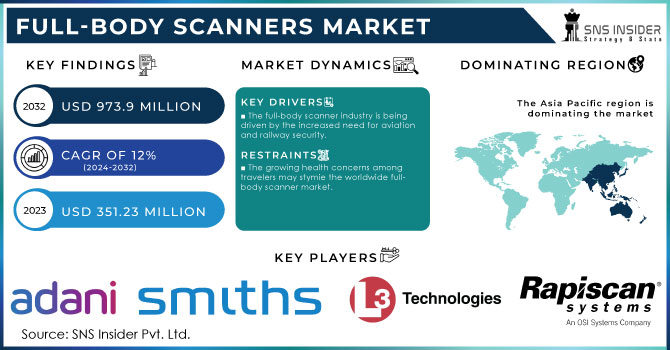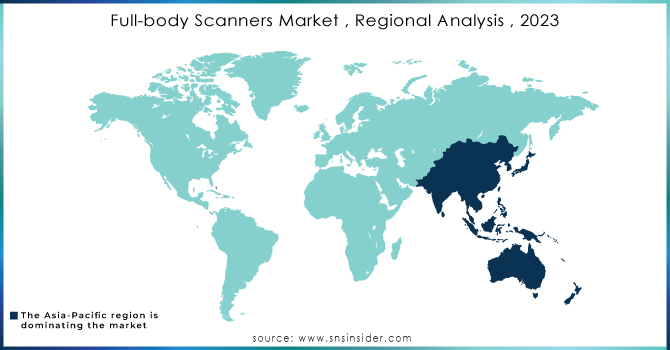Full-Body Scanners Market Size:
The Full-body Scanners Market Size was valued at USD 351.23 million in 2023 and is expected to reach USD 973.9 million by 2032, growing at a CAGR of 12% over the forecast period 2024-2032.

Get more information on Full-body Scanners Market - Request Sample Report
A full body scanner is a device for security scanning purposes that identifies objects inside or inside a person's body without removing clothing or physical contact. The user can see another image of the wavelength of a naked human body based on the material used, just a cartoon image of a person with an index showing where any suspicious object is displayed during an X-ray image of an object.
The short time taken by the passenger at the time of entry into the airport has boosted the growth of the full-body scanner market. Lack of grants or budget constraints arising from a lack of international government support for sport serves as a barrier to the full body scanner market. The growing technological advances such as AI, big data, and in-depth learning in a full-body scanner are creating various opportunities in the full-body scanner market. X-ray exposure from a scanner can lead to a mild effect that challenges the growth of the full-body scanner market.
This full body scanner market report provides market share details, new developments, and product pipeline analysis, impact on domestic and local market players, analyzes revenue in terms of revenue, changes in market rules, product approvals, strategies, and product launches, the expansion of space, and the renaming of technology in the market. To understand the analysis of the full body scanner market.
Full-body Scanners Market Dynamics:
KEY DRIVERS:
-
The full-body scanner industry is being driven by the increased need for aviation and railway security.
-
The need to prevent theft, drug smuggling, and human trafficking is driving up demand for full-body scanners.
RESTRAINTS:
-
The growing health concerns among travelers may stymie the worldwide full-body scanner market.
-
Passenger privacy concerns may limit the global whole-body scanner market.
IMPACT OF COVID-19
France, Russia, the UK, Italy, Germany, and Spain were among the countries most affected by Europe due to the COVID-19 outbreak. The region has seen a sharp decline in revenue from the tourism and tourism sectors. Europe is one of the key regions in terms of the growth of the Full-Body Scanner Market due to the presence of many developed countries. As government officials carry out various administrative measures such as temporary business closures, site closures, and travel restrictions, this has led to disruptions in the provision of the Full-Body Scanner Market as a series of related industry supply disruptions have been disrupted. Full-Body Scanner Market players have experienced significant flexibility in meeting product targets by 2020.
Moreover, as Europe’s largest ports were facing low shipping, the Full-Body Scanner Market saw a decline from the demand side by 2020. With the growth of vaccination policy, Europe was expected to return to normal soon. However, the third wave of COVID-19 hit hard in the UK, Germany, Russia, and France. Also, this is predicted to affect the demand for full-size body scanners at airports, banks, and other important infrastructure.
The transport category of the full-body scanners market is expected to develop at the fastest CAGR between 2023 and 2030. This segment's growth is related to advancements in passenger scanning technology, the expansion of existing airports and seaports, and the development of new airports, seaports, and railway stations. Since March 2020, the transportation sector has seen a major decline in passenger footfall, which is estimated to take 5-6 years to recover. As the market is predicted to recover and develop from 2023 to 2030, this will result in a higher CAGR.
The full-body scanners market has been divided into two categories based on technology: x-ray and millimeter wave. Because frequent and prolonged exposure to X-ray scanners can cause cancer and other ailments owing to radiation exposure, the millimeter wave segment is predicted to account for the majority of the market. Millimeter wave scanners are also widely used in prisons and critical infrastructure sectors.
The market has three categories based on output: single view, dual view, and 3D. In 2022, the dual view sector held a bigger market share than the single view and 3D segments combined. Dual-view scanners are more efficient than single-view scanners because they produce two images that can be utilized to detect contraband within the body. In dual-view scanners, the second image provides a crisper picture of the torso and can be utilized to identify contraband smuggled into organs or bodily cavities. Because the technology is still in its early stages, 3D scanners have seen limited acceptance.
Full-body Scanners Market Regional Analysis:
During the forecast period, the Asia Pacific market is expected to develop at the fastest CAGR. Changing demographics and a rise in disposable income in the region are boosting demand for air travel, leading to an increase in new airport expansions and expansion of existing airports, necessitating the installation of new passenger security systems in the region. Aside from increased passenger traffic, the region is home to a large number of prisons and convicts. As a result, the Asia Pacific region offers enormous prospects for full-body scanners.

Need any customization research on Full-body Scanners Market - Enquiry Now
KEY PLAYERS:
The major players operating in the market include L3 Technologies, Smiths Group plc, Adani Systems Inc., Rapiscan Systems Ltd., Iscon Imaging Inc., Nuctech Co. Ltd., OT-Morpho, Brijot Imaging Systems Inc, Braun Company & Other Players.
| Report Attributes | Details |
|---|---|
| Market Size in 2023 | US$ 351.23 Million |
| Market Size by 2032 | US$ 973.9 Million |
| CAGR | CAGR of 12% From 2024 to 2032 |
| Base Year | 2023 |
| Forecast Period | 2024-2032 |
| Historical Data | 2020-2022 |
| Report Scope & Coverage | Market Size, Segments Analysis, Competitive Landscape, Regional Analysis, DROC & SWOT Analysis, Forecast Outlook |
| Key Segments | • by Component (Hardware, Software) • by Output (Single View, Dual View, 3D) • by End-Use Sector (Transport, Critical Infrastructure) • by Detection (Manual, Automatic) • by Technology (X-ray, Millimeter Wave) |
| Regional Analysis/Coverage | North America (US, Canada, Mexico), Europe (Eastern Europe [Poland, Romania, Hungary, Turkey, Rest of Eastern Europe] Western Europe] Germany, France, UK, Italy, Spain, Netherlands, Switzerland, Austria, Rest of Western Europe]), Asia Pacific (China, India, Japan, South Korea, Vietnam, Singapore, Australia, Rest of Asia Pacific), Middle East & Africa (Middle East [UAE, Egypt, Saudi Arabia, Qatar, Rest of Middle East], Africa [Nigeria, South Africa, Rest of Africa], Latin America (Brazil, Argentina, Colombia, Rest of Latin America) |
| Company Profiles | L3 Technologies, Smiths Group plc, Adani Systems Inc., Inc., Rapiscan Systems Ltd., Iscon Imaging Inc., Nuctech Co. Ltd., OT-Morpho, Brijot Imaging Systems Inc, and Braun and Company Limited. |
| Key Drivers | • The full-body scanner industry is being driven by the increased need for aviation and railway security. • The need to prevent theft, drug smuggling, and human trafficking is driving up demand for full-body scanners. |
| Restraints | • The growing health concerns among travellers may stymie the worldwide full-body scanner market. • Passenger privacy concerns may limit the global whole-body scanner market. |

